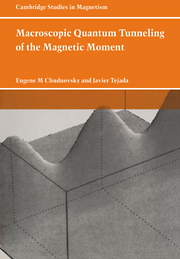Book contents
- Frontmatter
- Contents
- Preface
- Chapter I Introduction
- Chapter 2 Tunneling on a macroscopic scale
- Chapter 3 Magnetism in imaginary time
- Chapter 4 Magnetic tunneling in bulk materials
- Chapter 5 Quantum magnetic relaxation
- Chapter 6 Other experimental approaches
- Chapter 7 Tunneling in magnetic molecules
- References
- Index
Chapter 4 - Magnetic tunneling in bulk materials
Published online by Cambridge University Press: 16 October 2009
- Frontmatter
- Contents
- Preface
- Chapter I Introduction
- Chapter 2 Tunneling on a macroscopic scale
- Chapter 3 Magnetism in imaginary time
- Chapter 4 Magnetic tunneling in bulk materials
- Chapter 5 Quantum magnetic relaxation
- Chapter 6 Other experimental approaches
- Chapter 7 Tunneling in magnetic molecules
- References
- Index
Summary
Until now we have studied problems of homogeneous spin tunneling in small particles, in which we assumed the magnetic moment (or moments of sublattices) to be independent of spatial coordinates. In that case, as we have seen, the tunneling exponent is always proportional to the total tunneling spin. The particle, therefore, must be sufficiently small to provide a significant tunneling probability. When we switch to considering tunneling in bulk magnets, the same kind of argument can be made that suggests that magnetic tunneling can only occur in a small volume comparable to that in single-domain particles. A significant difference, however, is that a local tunneling event in a bulk magnet can trigger instability on a much greater scale, leading to really macroscopic consequences. Examples are quantum nucleation of magnetic domains and quantum depinning of domain walls, which are studied below. At the end of this chapter we will also briefly discuss tunneling of magnetic flux lines in superconductors.
Quantum nucleation of magnetic domains
Nucleation of magnetic bubbles in thin ferromagnetic films is an interesting fundamental problem that may have great potential for experimental studies. Consider a thin film of ferromagnetic material with strong perpendicular anisotropy, which is uniformly magnetized in the positive Z-direction, Fig. 4.1. The magnetic field is applied in the negative Z-direction, which favors the reversal of the magnetization. The reversal occurs via the nucleation of a critical bubble that then grows in size until the magnetization of the whole film has become aligned with the direction of the field.
- Type
- Chapter
- Information
- Macroscopic Quantum Tunneling of the Magnetic Moment , pp. 61 - 83Publisher: Cambridge University PressPrint publication year: 1998



